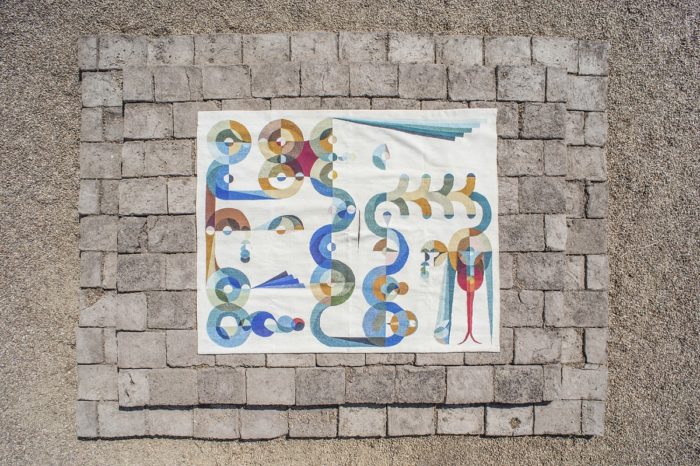Tiempo de lectura: 3 minutos

24.09.2017
Ballroom Marfa, Marfa, Texas, USA
25 de agosto de 2017 – 18 de marzo de 2018



Tierra. Sangre. Oro. is a group exhibition envisioned by Rafa Esparza that includes new work by Carmen Argote, Beatriz Cortez, Esparza, Timo Fahler, Eamon Ore-Giron; new and existing photographs by Star Montana; a major body of work by Nao Bustamante; the contributions of adoberos/artists Sandro Cánovas, Maria Garcia, Ruben Rodriguez, as well as many hands from the community of Marfa.
Rafa and I began a conversation in June 2016. I had followed his work closely before we met, and had seen two of his adobe interventions next to the Los Angeles River, building: a simulacrum of power (2014) and Con/Safos (2015). The generous and generative nature of his practice was immediately apparent to me, each architecture offering itself up both as a surface for other artists and as a physical embodiment of labor and land. Those two projects convinced me that Rafa should come to Marfa to see the vernacular adobe architecture of the region, and many months later we started dreaming, together, about a project for Ballroom.
It has been a great privilege to work with Rafa and all of the artists that manifested this exhibition. In Marfa, Rafa worked alongside Sandro Cánovas, Maria Garcia, and Ruben Rodriguez for over two months, mixing adobe and molding bricks, to produce tons of building material that he used to create a rich ground for his peers and Ballroom’s visitors.
Beatriz Cortez and Rafa collaborated on reorienting the entrance to Ballroom’s galleries, and together built an arch inspired by ancient Mayan architecture. Now, visitors are invited to pass through an entry point of the artists’ own creation, and to move through the galleries from north to south, towards the border and Mexico. Most of the bricks for this monumental structure were made by Don Manuel Rodriguez, an expert adobero living in Ojinaga, Mexico, and were brought over the border particularly for this sculpture.
Star Montana’s striking medium format portraits of female-identifying people of color confront viewers from their monumental adobe mounts at the front of the gallery. Most of Star’s portraits are taken in her community in Los Angeles, but Maria was made in Marfa at the worksite where artist Maria Garcia built bricks with Rafa for the exhibition. Rafa’s four hulking adobe structures that hold up these portraits are named in honor of Aztec deity Coatlicue, the mother of the gods, the sun, the moon and the stars.
Carmen Argote spent two weeks in Marfa meeting locals by collecting their cardboard boxes. From these disposable containers, Carmen created the large painted tapestry hanging in the center gallery, that maps both shapes and interactions. She created playful paper mache sculptures to echo the muslin hanging, as well as two wearable mantas that reflect Marfa’s singular skies. Eamon Ore-Giron’s wool pancho, Talking Shit with Quetzalcoatl… is wearable too, woven by craftsmen in Guadalajara, it is a translation of one of the artist’s iconic compositions. A pair of adobe plinths by Esparza, one indoors and one outdoors, are tailored to the weaving’s dimensions. The plinth outside provides a space for the pancho to be spread out and sat upon, used as a blanket for contemplation and conversation, and a stage for performances to come.
Timo Fahler’s hydrocal spikes border the courtyard, evoking a homemade security system, monstrous teeth or snake-like forms. Timo spent weeks working alongside Rafa as well, pouring adobe in cinderblock molds and experimenting with colliding those two dissimilar building modes. The resulting stacks and structures become bodily proxies, occupied by found objects, cacti, and colorful appendages.
Nao Bustamante’s expansive body of work around soldaderas, the under recognized women soldiers of the Mexican Revolution, occupies the south gallery. Rafa’s adobe floors and pedestal ground Nao’s videos, Kevlar costumes, historic photographs, and objects. The installation re-presents and reinvents the soldadera’s role in the Revolution and in the present day, re-inserting her into history and into our contemporary consciousness as a symbol of strength and power. Just outside of Nao’s installation, visitors are invited to flip through books on adobe building practices and admire the collection of gavelas, adobe brick molds, are from Sandro Cánovas’s personal collection.
Altogether Tierra. Sangre. Oro. is many things: It is a group exhibition but it is also over 2,000 adobe bricks; it is, in Rafa’s words “a Brown laboratory”; it is a platform for artworks and performances and happenings; it is a conversation between artists manifested in space.
– Laura Copelin
Curator and Director
Comentarios
No hay comentarios disponibles.